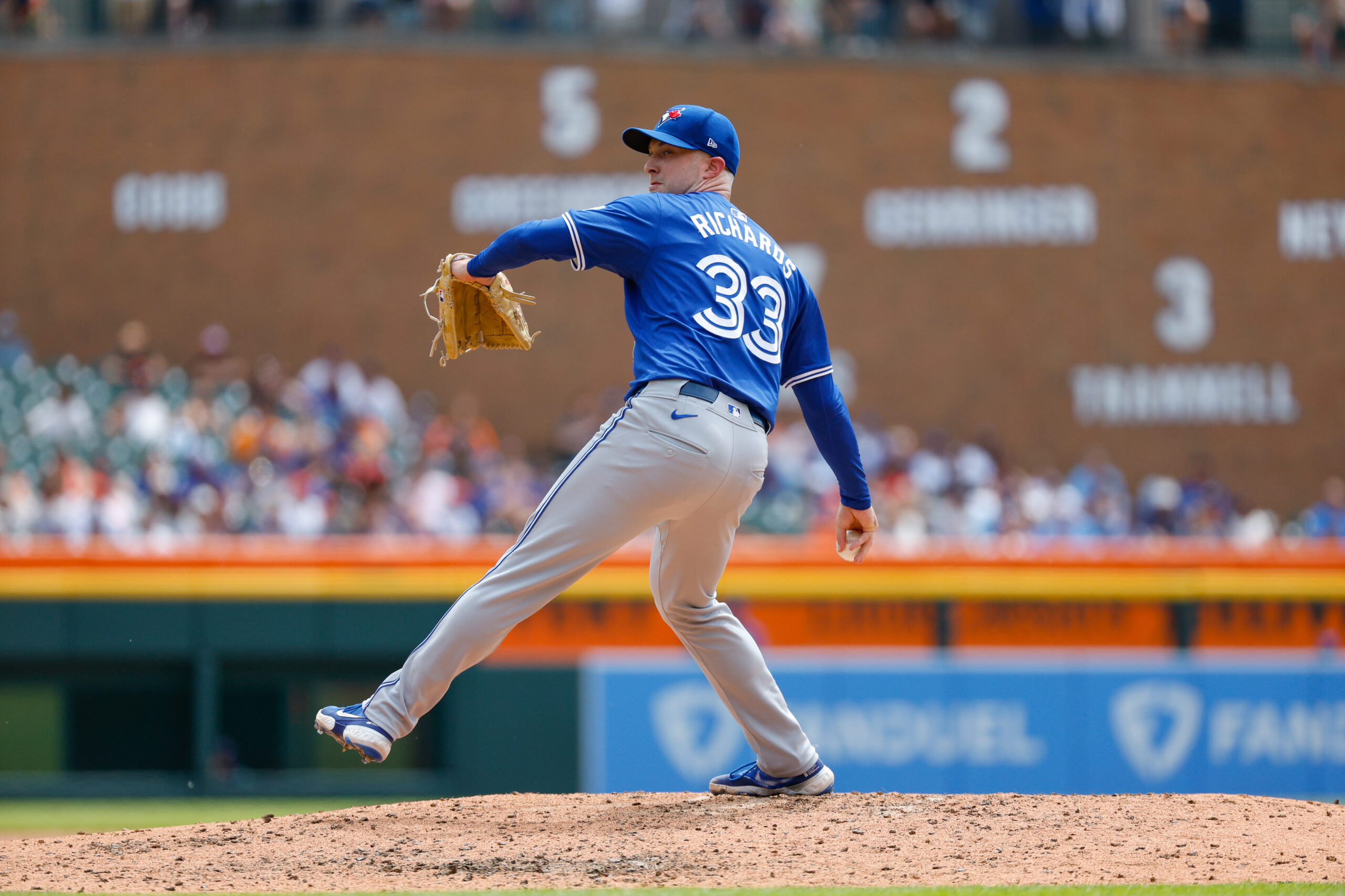
Leading a ballgame has been tough enough for the Toronto Blue Jays in 2024, and maintaining one has quickly become just as challenging these days, too.
This club currently finds itself with its top three high-leverage relievers: closer Jordan Romano (injured), Erik Swanson (minors) and Yimi García (injured), who hit the 15-day IL over the weekend, further weakening an already depleted bullpen. And, as Tuesday night’s deflating loss proved, not having any of those three available puts the rest of the bullpen at a significant disadvantage.
How Toronto will bridge the later innings to Chad Green — who’ll now assume most of the closing duties — will be a huge question mark with multiple high-leverage arms unavailable. A night ago, Nate Pearson and Brendon Little were tasked with that responsibility, of course, and the latter of that duo failed to achieve that feat, coughing up a 3-2 lead.
As Little allowed a pair of runs, the Blue Jays’ bullpen ERA climbed to 4.68 on the season, which ranks 26th in the majors entering Wednesday’s slate. Unfortunately, their bullpen woes don’t end there as they sit 30th in FIP (4.93), HR/9 (1.56), hard-hit rate against (42.7 per cent), barrel rate against (9.7 per cent) and fWAR (-1.1).
What was a top 10 ‘pen last season has morphed into arguably the worst in baseball just one year later. That would be extremely troubling for any team. But especially for a Blue Jays squad that’s repeatedly demanded perfection from its pitching and defence because of poor offensive production.
The bullpen has to be much, much better than what it’s shown thus far to have any hope of keeping their bleak playoff hopes alive. That’s not an easy task without Romano, Swanson and García. So, in the meantime, others will have to step up and help stop the bleeding for a ‘pen running on fumes.
Trevor Richards
2024 stats: 31 games (37 innings) — 2.92 ERA, 3.97 FIP, 13.2% K-BB%
You could argue that Richards doesn’t receive enough appreciation for his role on this team. Statistically speaking, he hasn’t been as effective as he was in 2023 — his strikeout, whiff and chase rates are all down considerably from last season. But try finding someone who can operate in any situation asked of him, and the Blue Jays need him to change on the fly again.
Amidst a shortage of high-leverage relievers, the 31-year-old will need to help bridge the gap to Green in the seventh and eighth innings, temporarily shifting away from his multi-inning role. However, rediscovering his elite swing-and-miss levels will be crucial, given he’ll surely be called into tight jams that require a punchout or two.
Richards placed in the 97th percentile or higher in strikeout (33.3 per cent), whiff (36.8 per cent) and chase rates (37.5 per cent) in 2023. This season, though, he hasn’t soared higher than the 64th percentile in any of those categories, with his career-low 24.2-per-cent whiff rate plummeting to the 42nd.
Trevor Richards, Mean Changeups. 👌👌 pic.twitter.com/5lNJkfDUgR
— Rob Friedman (@PitchingNinja) June 15, 2024
Hitters have adjusted to Richards’ devasting changeup, which owns a respectable 31.1-per-cent whiff rate this season, down from the 47.8-per-cent clip that finished second among qualified big-league hurlers (min. 100 changeups) last season. They’re swinging at it about 10 per cent less, sitting on his low-90s fastball in the upper half of the strike zone rather than offering at his lethal off-speed weapon in the lower half.
It’s similar to how most lineups attack Kevin Gausman. If they see it low, they let it go. If they see it high, they let it fly. Though Richard doesn’t possess the velocity his teammate does, he may also need to start throwing more knee-high heaters to reduce the amount of takes versus his changeup, particularly in two-strike counts.
That way, his chances of putting out game-altering fires should be substantially higher than they’ve been up to this point in his fourth — and potentially final — season with Toronto, as a free agent this fall and potentially an appealing trade chip next month.
Génesis Cabrera
2024 stats: 29 games (27.2 innings) — 4.55 ERA, 5.40 FIP, 2.5% K-BB%
The numbers haven’t popped off the page for Cabrera like they did after he arrived in a trade from the St. Louis Cardinals last season. But, if you can believe it, he’s improved quite a lot lately.
Over his last nine relief appearances, Cabrera has a 3.60 ERA and 3.05 FIP with five strikeouts, only two walks allowed and a hit-by-pitch across 10 innings. He’s been rather trustworthy outside of one blowup versus the Baltimore Orioles on June 4, where he surrendered three earned runs on one hit, a walk and a HBP over just two-thirds of an inning.
That’s a massive step forward from the 15 runs (10 earned), 23 hits, 11 walks and 11 strikeouts he recorded in his first 20 outings, accounting for a 5.09 ERA and 6.72 FIP. Even more impressive is he’s given up just one home run since May 1.
With fellow lefties Tim Mayza and Little proving ineffective, Cabrera will likely be an important weapon for manager John Schneider to deploy in pivotal spots versus left-handed hitters, as will Richards, who features quality reverse splits. Both should receive plenty of opportunities in those matchup windows through the rest of June.
They’ll undoubtedly go head-to-head with the likes of Jarren Duran, Rafael Devers and Masataka Yoshida versus Boston, a lineup loaded with lefties and switch-hitters in Cleveland — most notably José Ramírez — and face a leading AL MVP candidate in Juan Soto against New York.
To say that stretch will be challenging would vastly understate the Blue Jays’ upcoming slate.
Nate Pearson
2024 stats: 30 games (28.1 innings) — 4.13 ERA, 4.00 FIP, 18.3% K-BB%
Amid a make-or-break year in Toronto, things are seemingly coming together for Nate Pearson, who’ll be out of minor-league options after this season. While it’s been touch and go at times, he’s quietly adjusting to this new version of himself in the ‘pen.
One of the first things you think of when Pearson toes the rubber is his explosive 100-m.p.h. fastball, right? Well, that’s no longer his best pitch in 2024. Instead, it’s now his hard-breaking slider, which leads his arsenal with a +3 run value. It’s responsible for 13 of his 35 strikeouts, producing a 37.6-per-cent whiff rate.
Nate Pearson, Dirty 86mph Slider. 😨 pic.twitter.com/PrfpaRUw6m
— Rob Friedman (@PitchingNinja) July 5, 2023
Pearson threw more sliders than fastballs in May, using his primary breaking ball nearly 50 per cent of the time, with opponents going 2-for-18 (.111) and whiffing to a 43.2-per-cent clip against it. Granted, he’s hung a few over the plate that have left the yard this month, but it’s become a pitch he actively sets up with his heater.
Consistency, of course, remains the ultimate defining factor with Pearson. That said, he has enjoyed a successful run in this recent sample size, limiting the opposition to one run on five hits and a walk while striking out seven over his last six relief appearances — four of which occurred in high-leverage situations.
The more confidence he gains in those high-stress environments, the more opportunities he’s likely to earn moving forward.


